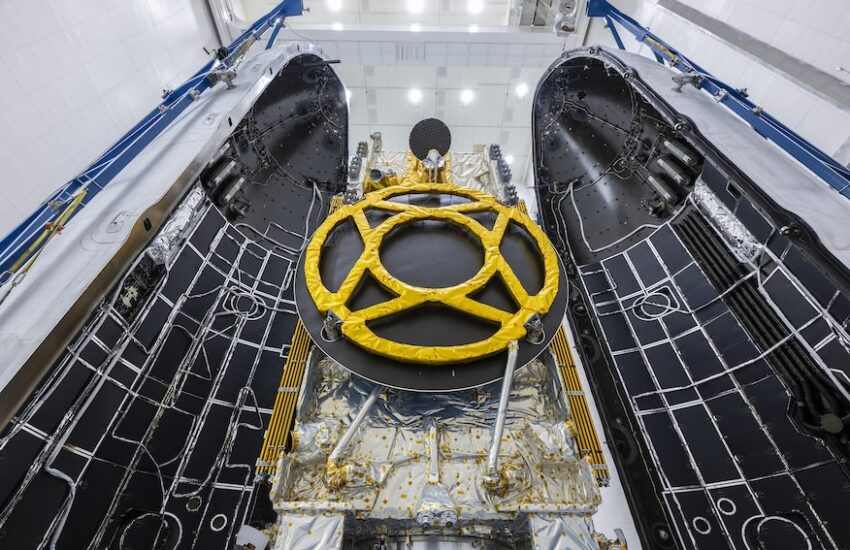
Update 8:28 p.m. EDT: SpaceX stood down from the Tuesday launch opportunity due to high winds.
Poor weather once again scuttled SpaceX’s plans for a Falcon 9 launch on Tuesday evening. They hoped to send the Astra 1P satellite to geostationary transfer orbit (GTO) on behalf of one of its oldest customers: Luxembourg-based SES. The prolific launch company now turns to the West Coast launch of the Starlink 9-1 mission in hopes of bouncing back from an unusually quiet period in its launch cadence, accented by a last-second abort as the engines on another one of its Falcon 9 rockets began to fire.
Liftoff of the mission was set for 8:23 p.m. EDT (0023 UTC), but it scrubbed about five minutes before launch.
The Falcon 9 first stage booster supporting this mission, tail number B1080 in the SpaceX fleet will launch for a ninth time. It previously supported the launches of two private astronaut missions for Axiom Space (Ax-2 and Ax-3), the European Space Agency’s Euclid observatory and four Starlink missions.
About 8.5 minutes after liftoff, B1080 will land on the SpaceX droneship, ‘Just Read the Instructions.’ If successful, this will make the 84th booster landing for JRTI.
Weather wasn’t ideal coming into this launch attempt. A forecast issued Monday by the 45th Weather Squadron showed a 55 percent chance of favorable weather, but noted that liftoff winds, cumulus clouds and the possibility of lightning are all potential threats. Meteorologists were also tracking upper-level wind shear between low and moderate levels of impact.
The 24-hour backup scenario on Wednesday fares worse from a weather perspective. The odds of favorable weather drop to 45 percent and the booster recovery weather also deteriorates as well.

SpaceX is working its way through a rare stretch of time without a Falcon 9 launch. Its last launch will be 10 days prior, if it manages to launch the Starlink 9-1 mission from Vandenberg Space Force Base on June 18.
The last time there was a gap of this many days was between the launches of Starlink 7-8 on Dec. 8, 2023, and Starlink 6-34 on Dec. 19, 2023. Since the latter mission, SpaceX launched 64 orbital missions, one of which was a Falcon Heavy rocket.
Kiko Dontchev, the vice president of Launch at SpaceX, wrote on X (formerly Twitter) about the ignition scrub during the Starlink 10-2 launch attempt on Friday. Without going into detail, he said that what prevented the launch was “a real issue,” which would require SpaceX to “go inspect the hardware in detail on this vehicle.”
“This will be the first week we’ve gone without a Falcon Launch in a long time. Unplanned downtime due to weather or unexpected issues happens, it’s how we respond that matters,” Dontchev wrote. “The launch business takes grit and when things go wrong, our true form comes to life. Bring it on!!!”
Welcome back, SES
Onboard what will now become SpaceX’s 62nd Falcon 9 launch of 2024 is the Astra 1P satellite, which is also referred to as SES-24. The Luxembourg-based telecommunications company is a long-time customer of SpaceX’s launch services.
In fact, the first payload that a Falcon 9 launched to geostationary transfer orbit (GTO) was SES-8 on Dec. 3, 2013 on the seventh of the rocket.
The forthcoming Astra 1P satellite continues a legacy of television satellites in the Astra 19.2°E group that goes back to Astra 1A, which launched in 1988. There are currently four satellites in use within this orbital position: Astra 1KR, Astra 1L, Astra 1M and Astra 1N.

Astra 1KR and Astra 1L were manufactured by Lockheed Martin, while Astra 1M and Astra 1N were built by Astrium (now Airbus Defene and Space). In 2021, SES contracted Thales Alenia Space to manufacture Astra 1P and Astra 1Q.
Both Astra 1P and Astra 1Q will feature direct-to-home (DTH) functionality, but the latter will also be “customizable on orbit and can be deployed easily to other orbital positions.”
“Our prime TV neighborhood at 19.2°E is one of our most valuable assets and has been key to enabling renowned European broadcasters to grow their TV audiences in the last 30 years. These two satellites will have the resiliency, reliability and redundancy that our video customers need, and will be able to deliver continued premium services well into 2040,” said Steve Collar, the former CEO of SES, in a 2021 statement. “Additionally, thanks to advanced satellite technology, we will be future-proofing our investment and injecting a high degree of flexibility into ASTRA 1Q to ensure we are meeting the evolving needs of all the markets we serve.”
Prior to launch, in a recorded statement, Adel Al-Saleh, the current CEO of SES, said Astra 1P is designed to replace the four satellites currently stationed at the 19.2°E position.
“This satellite will serve some of our largest media customers, like Sky, Canal+, Telefónica and RTL to deliver the valued, high quality content to their customers,” Al-Saleh said. “And it will also address the growing demand of sports and events, so that customers, like the NFL and various football leagues, can easily distribute their content across Europe.”


